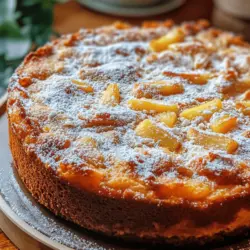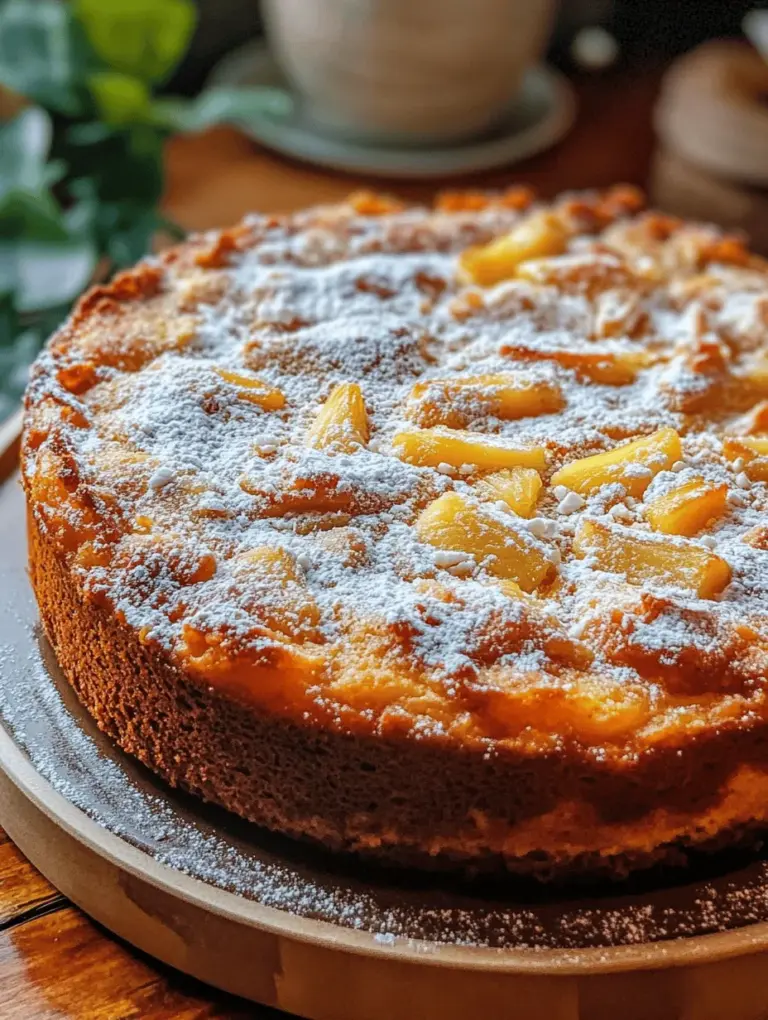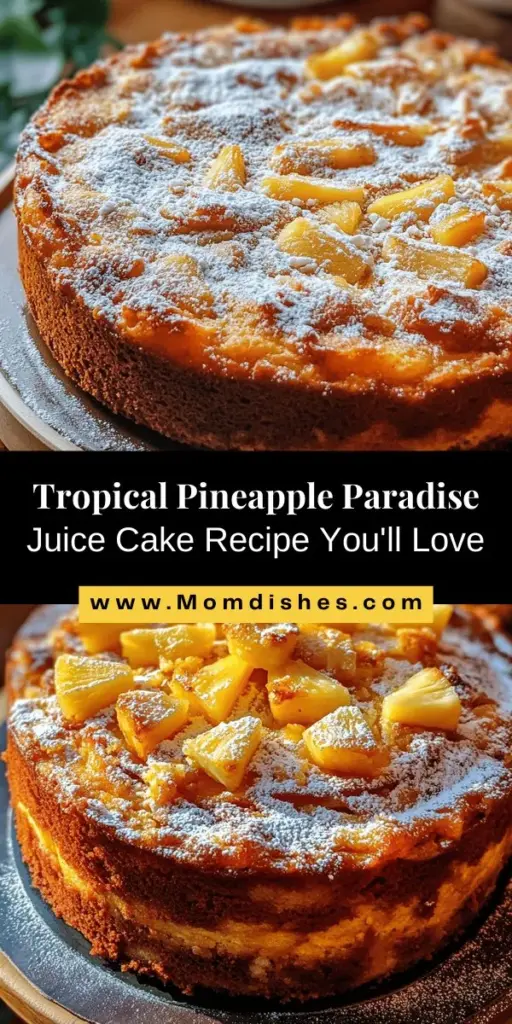Baking is a beautiful way to explore tropical flavors, and there’s no better representation of this than the Pineapple Paradise Juice Cake. This delightful dessert transports you straight to a sun-kissed beach, where the sweet scent of ripe pineapples and the creamy notes of coconut fill the air. The combination of fresh ingredients not only elevates the taste but also brings a sense of lightness and refreshing quality that is perfect for any occasion—be it a summer picnic or a cozy family gathering.
The Pineapple Paradise Juice Cake is more than just a cake; it’s an experience. With every bite, you’ll find yourself enveloped in tropical bliss, making it an excellent choice for those who want to indulge in something sweet yet refreshing. The cake’s moist texture, enhanced by fresh pineapple juice and complemented by the subtle crunch of coconut, makes it a crowd-pleaser that can impress your friends and family alike.
Understanding the Ingredients
To create a truly delicious Pineapple Paradise Juice Cake, it’s essential to understand the key ingredients and their roles in achieving the perfect flavor and texture. This cake is built on the foundation of quality ingredients, each contributing to a harmonious balance that defines this tropical treat.
All-Purpose Flour
All-purpose flour is the backbone of any cake, providing the necessary structure and stability. It helps the cake rise and gives it a light, fluffy texture. When measuring flour, it’s important to use the scoop-and-level method to ensure you don’t end up with too much, which can lead to a dense cake.
Granulated Sugar
Sugar does more than just sweeten the cake; it also plays a crucial role in moisture retention. Granulated sugar helps to create a tender crumb by attracting and holding onto moisture, ensuring that each slice remains soft and delicious. The balance of sugar is vital—too little can result in a dry cake, while too much can make it overly sweet.
Fresh Pineapple Juice
The star of the show is undoubtedly fresh pineapple juice. It serves as the primary source of flavor and moisture, infusing the cake with a vibrant tropical taste. The acidity from the juice also helps to activate the baking soda, contributing to the cake’s rise. Opting for fresh juice over canned provides a brighter, more pronounced flavor.
Unsalted Butter
Unsalted butter is essential for achieving the desired creaminess and richness in the cake. Creaming butter with sugar creates air pockets, which help the cake rise as it bakes. Using unsalted butter allows you to control the overall saltiness of the cake, letting the flavors shine through without being overwhelmed.
Eggs
Eggs are a binding agent in baking, helping to hold all the ingredients together. They add moisture and richness to the cake, contributing to its overall texture. Be sure to use room-temperature eggs, as they incorporate better into the batter, leading to a more uniform mixture.
Vanilla Extract and Lemon Zest
The combination of vanilla extract and lemon zest acts as a flavor booster, enhancing the overall taste experience of the cake. Vanilla adds a warm sweetness, while lemon zest introduces a refreshing zing that brightens the tropical flavors.
Baking Powder, Baking Soda, and Salt
These leavening agents are crucial for achieving the cake’s rise and lightness. Baking powder and baking soda work together to create carbon dioxide bubbles, which expand during baking, giving the cake its fluffy texture. A pinch of salt is essential for balancing flavors and enhancing the sweetness.
Optional Ingredients: Crushed Pineapple and Shredded Coconut
To elevate the cake’s tropical character, you may choose to include crushed pineapple and shredded coconut. Crushed pineapple adds additional moisture and texture, while shredded coconut brings a delightful chewiness and enhances the coconut flavor. Both ingredients can be adjusted to personal preference, allowing you to customize your cake experience.
Preparation Steps for Pineapple Paradise Juice Cake
Now that we’ve covered the essential ingredients, it’s time to dive into the preparation steps for creating this heavenly Pineapple Paradise Juice Cake. Following these detailed instructions will ensure that your cake turns out perfectly every time.
Prepping the Baking Pan
Before you begin mixing your batter, it’s crucial to prepare your baking pan. Proper greasing and lining of the pan will prevent your cake from sticking and ensure a smooth release after baking. Start by preheating your oven to 350°F (175°C).
Choose a 9×13-inch baking pan for this recipe. Use unsalted butter or cooking spray to grease the bottom and sides thoroughly. For extra precaution, consider lining the bottom with parchment paper, allowing you to lift the cake out effortlessly once it has cooled.
Mixing the Dry Ingredients
Next, gather your dry ingredients in a large mixing bowl. Combine all-purpose flour, baking powder, baking soda, and a pinch of salt. Whisk them together until they are well mixed. This step is essential for achieving a uniform blend, ensuring that the leavening agents are evenly distributed throughout the flour.
Creaming Butter and Sugar
In another bowl, begin the creaming process by combining unsalted butter and granulated sugar. Using an electric mixer on medium speed, cream the butter and sugar together until the mixture becomes light and fluffy, which typically takes about 3-5 minutes. This step is crucial as it incorporates air into the mixture, contributing to the cake’s rise.
Incorporating Eggs and Flavorings
Once the butter and sugar are adequately creamed, it’s time to add the eggs, one at a time. Mixing in each egg individually allows for better incorporation and results in a smoother batter. After adding the eggs, pour in the vanilla extract and lemon zest, mixing until everything is well combined.
Adding Pineapple Juice
With the wet ingredients ready, it’s time to incorporate the fresh pineapple juice. Gradually pour the juice into the batter while mixing on low speed. This ensures an even distribution without splattering the juice everywhere. The addition of pineapple juice will create a luscious, moist batter that is a delight to work with.
Combining Wet and Dry Ingredients
Finally, it’s time to bring the dry and wet ingredients together. Start by adding about half of the dry mixture to the bowl of wet ingredients, mixing gently until just combined. Then, pour in the remaining dry ingredients and mix until no flour streaks remain. Be careful not to overmix, as this can lead to a dense cake. The goal is to achieve a smooth, thick batter that will be packed with tropical flavor.
In the next part of our article, we will delve deeper into baking tips, cooling methods, and icing options that will perfectly complement your Pineapple Paradise Juice Cake. Stay tuned for more on how to elevate this delightful dessert to new heights!
{{image_1}}
Folding in Optional Ingredients: How to Maintain Texture and Flavor Balance
When creating your Pineapple Paradise Juice Cake, you have the option to enhance its flavor and texture by incorporating various ingredients. Common additions include shredded coconut, chopped nuts, or even a hint of fresh lime zest. To maintain the cake’s light and fluffy texture, it’s essential to fold these ingredients in gently. This technique prevents the batter from deflating, ensuring that your cake remains airy and enjoyable.
Begin by adding your chosen optional ingredients to the batter after mixing in the pineapple juice and other wet components. Use a rubber spatula to carefully fold in the ingredients, working them through the batter with a gentle motion. This method preserves the volume you’ve created during mixing while evenly distributing the flavors.
Baking Process
Optimal Baking Temperature and Time
For the best results, preheat your oven to 350°F (175°C) before placing your Pineapple Paradise Juice Cake inside. This step is crucial as it ensures even cooking and the proper rise of the cake. Once the oven reaches the desired temperature, pour your batter into a greased cake pan, smoothing the top with a spatula. Bake the cake for approximately 30 to 35 minutes, but keep an eye on it towards the end of the baking time.
Visual Cues for Doneness
To check if your cake is properly baked, you can use a toothpick or skewer inserted into the center of the cake. If it comes out clean or with just a few crumbs attached, your cake is ready. Another visual cue is to observe the edges of the cake; they should begin to pull away slightly from the sides of the pan, and the top should have a golden-brown hue.
Importance of Cooling
Once baked, remove your cake from the oven and let it cool in the pan for about 10 minutes. This initial cooling period allows the cake to set and makes it easier to remove from the pan without breaking. After 10 minutes, gently run a knife around the edges and turn the cake out onto a wire rack to cool completely. Proper cooling enhances the flavor development and ensures that the texture remains moist and tender.
Finishing Touches
Dusting with Powdered Sugar
After your cake has cooled completely, consider dusting it with powdered sugar. This simple step adds a touch of elegance and a bit of extra sweetness to contrast with the tropical flavors of the cake. Use a fine mesh sieve to sprinkle the sugar evenly over the top, creating a beautiful, inviting finish.
Presentation Tips
For serving your Pineapple Paradise Juice Cake at gatherings or special occasions, presentation is key. Place the cake on a decorative cake stand to elevate its visual appeal. You can also garnish each slice with a slice of fresh pineapple or a dollop of whipped cream to enhance its tropical theme. Consider serving the cake alongside a scoop of vanilla ice cream or a light fruit salad for a refreshing combination that complements the flavors of the cake.
Flavor Profile and Texture Analysis
Description of the Cake’s Taste
The Pineapple Paradise Juice Cake is a harmonious blend of sweetness and tropical flavors. The natural sweetness of the pineapple juice infuses the cake with a delightful fruity taste that is balanced by the slight tang from the pineapple itself. This combination creates a refreshing dessert that is perfect for warm weather or any occasion where you want to impress your guests with something unique.
Discussion on Texture
This cake boasts a moist, fluffy, and light texture that melts in your mouth. The use of juice instead of heavy dairy makes it a lighter option, while the gentle folding of ingredients ensures that it rises beautifully. The addition of any optional ingredients, such as coconut or nuts, can add a delightful crunch, providing a contrast to the cake’s softness.
Pairing Suggestions
To enhance your dessert experience, consider pairing your Pineapple Paradise Juice Cake with beverages such as coconut water, iced tea, or a refreshing lemonade. For those who prefer something stronger, a tropical cocktail like a piña colada or a light white wine can complement the sweet and tangy flavors of the cake.
Nutritional Insights
Overview of the Cake’s Nutritional Profile
While this cake is laden with delightful flavors, it is essential to understand its nutritional profile. A standard slice of Pineapple Paradise Juice Cake contains approximately 250 calories, with 10 grams of fat and about 20 grams of sugar. The cake provides a moderate amount of carbohydrates, making it a delightful treat in moderation.
Discussion on the Use of Fresh Ingredients
Incorporating fresh ingredients, such as real pineapple juice and fruit, not only enhances the flavor but also adds nutritional value. Pineapple is rich in vitamins C and B6, manganese, and dietary fiber, making this cake a more beneficial dessert option than many others that rely on artificial flavors and preservatives.
Considerations for Dietary Restrictions
If you or your guests have dietary restrictions, consider modifying the recipe for gluten-free options. You can easily substitute the all-purpose flour with a gluten-free flour blend, ensuring that everyone can enjoy a slice of this tropical delight. Additionally, for a lower sugar version, natural sweeteners like honey or maple syrup can be used, although adjustments in moisture levels may be necessary.
Cultural Context of Pineapple in Baking
Exploration of Pineapple in Global Cuisines
Pineapple holds a significant place in global cuisines, especially in tropical regions where it is grown abundantly. In Hawaii, for instance, pineapple is not just a fruit; it is an integral part of the culinary culture, often featured in various dishes and desserts. The use of pineapple in baking is celebrated in many cultures, from the classic upside-down pineapple cake to refreshing sorbets and pastries.
Historical Relevance of Pineapple in Desserts
Historically, pineapple has been associated with hospitality and luxury. In the Victorian era, it was considered a symbol of wealth and was often featured in elaborate desserts at banquets. Today, pineapple is embraced in modern baking, where its versatility continues to inspire chefs and home bakers alike. The Pineapple Paradise Juice Cake is a testament to this evolution, marrying traditional flavors with contemporary techniques.
Conclusion
The Pineapple Paradise Juice Cake is not just a dessert; it is a celebration of tropical flavors and culinary creativity. Its refreshing taste, moist texture, and stunning presentation make it an excellent choice for any gathering or special occasion. By trying out this recipe, you embark on a delightful baking journey that promises to bring smiles and satisfaction to your family and friends.
So, gather your ingredients and let the aroma of freshly baked cake fill your kitchen. Enjoy the process of baking, and relish the joy of sharing this delicious homemade treat. Whether it’s for a summer barbecue, a birthday party, or simply a sweet indulgence at home, the Pineapple Paradise Juice Cake is sure to become a favorite in your dessert repertoire. Happy baking!


